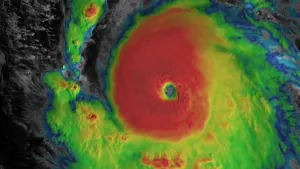
Where to see bright Comet Tsuchinshan-ATLAS for the rest of October
Keep your eyes trained to the western sky after sunset for a chance to spot this brief visitor from the edge of our solar system.
Comet C/2023 A3 (Tsuchinshan-ATLAS) has travelled for millions to billions of years to reach us, and we'll only be able to see the cosmic visitor for a short period of time.
Each reasonably clear night from now until the end of October, just after the Sun has set, turn towards the western horizon. It may take a few moments of focus to spot it, or you may even need your phone, or a pair of binoculars, or a telescope, but if you look very closely, you can spot a bright dot with a long tail pointing up into the sky. This is comet C/2023 A3 (Tsuchinshan-ATLAS), (aka Comet Tsuchinshan-ATLAS, or Comet A3).
Discovered in early 2023, this immense ball of ice, rock, and dust has apparently been falling towards the inner solar system for over a billion years, as it appears to originate from the Oort Cloud — the collection of inert comets that surrounds us out at the edge of our solar system. Estimated at over 3 kilometres wide, the nucleus of this comet is putting out enough dust and ice to produce a tail roughly 40 times longer than the width of the Full Moon.

TeamTanner Aurora and Weather Chasers captured these two images of comet A3, on the night of October 14 (left) and October 15 (right). Both images show off the comet's spectacularly long tail, which is made up of dust and ionized gas. Also faintly visible pointing towards the ground is the comet's "anti-tail", which is composed of larger dust particles left behind in the comet's orbit (Tree and Dar Tanner)
Observers have already reported that the comet is visible to the naked eye (a rarity!), although depending on how soon after sunset it is, some assistance may be needed to spot the comet against the light of dusk.
"The brightness of comets is measured on the same scale we use for stars, one that has been in use since roughly 150 B.C., when it was devised by the ancient scholar Hipparchus and refined by the astronomer Ptolemy," says NASA. "Stellar magnitude is measured on a logarithmic scale, which makes a magnitude 1 star exactly 100 times brighter than a magnitude 6 star. The lower the number the brighter the object, making it more likely to be clearly seen, whether by telescope or the naked eye."
"At peak visibility in the northern hemisphere, Tsuchinshan-ATLAS's brightness is estimated at between 2 and 4," NASA explained. "In comparison, the brightest visible star in the night sky, Sirius, has a magnitude of –1.46. At its brightest, solar reflection from Venus is a magnitude of –4. The International Space Station sometimes achieves a relative brightness of –6."
Each night, Comet A3 will be higher in the sky as the Sun sets. Thus, it will spend more time above the horizon before it sets, which will give those of us with clear skies more time to spot it. However, at the same time, each night the comet will be farther away, and thus dimmer, than the night before.
So, we may only have a week, or perhaps two, to see this visitor before it gets too faint for all but the largest telescopes, and it disappears, not to be seen again by anything on Earth for tens to hundreds of thousands of years.

Be sure to check out The Weather Network's Stargazing Photo Gallery for pictures of the comet uploaded by our readers and viewers. Plus, if you happen to take any pictures of Comet A3, yourself, consider sharing them on the platform so that everyone can see this amazing celestial object in the sky.
Thumbnail image courtesy Jeff Shodin, who captured this picture of Comet A3 from just west of Winnipeg on October 14, 2024.










